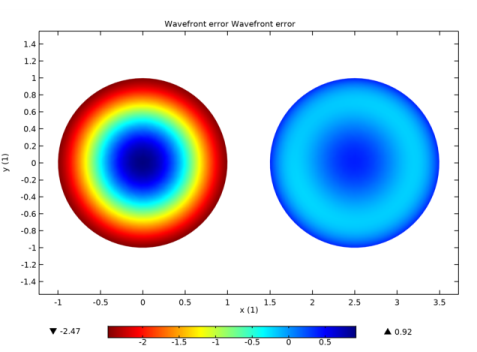The Optical Aberration plot can be added in a
2D Plot Group whereas the
Aberration Evaluation node is available under
Derived Values. Both of these postprocessing features serve a similar purpose: to quantify the monochromatic aberrations of an imaging system and express them in terms of Zernike polynomial coefficients. In order to use the
Optical Aberration plot, the following prerequisites must be met:
Using the hemisphere defined in the Intersection Point 3D dataset, a Gaussian reference sphere is defined. The optical path difference among intersection points with this sphere is then expressed as a sum of Zernike polynomials.
Alternatively, using the Optical Aberration plot, you can use the
Create Reference Hemisphere Dataset button in the
Focal Plane Orientation section to automatically generate a reference hemisphere at the location of the rms focus. However, note that the defocus term
Z(2,0) might be larger for the rms focus than it would for some other definitions of the image plane, such as the marginal focus.
The monochromatic aberrations in a double Gauss lens system are shown in Figure 2-12. The circle on the left shows the sum of all Zernike coefficients. The circle on the right ignores the defocus term
Z(2,0) and the piston term
Z(0,0). Usually, lower-order Zernike terms can be reduced by correcting misalignments in the optical system or adjusting the nominal focus. Higher-order terms are consequences of the type of lens or mirror used in an optical system; for example, a single spherical lens will always demonstrate some spherical aberration, for any position of the nominal focus.
The Optical Aberration plot always shows the optical path differences on a unit circle. The color expression is the wavefront error in microns. In the circle on the right in
Figure 2-12, the largest contribution is from the spherical aberration term
Z(4,0).
